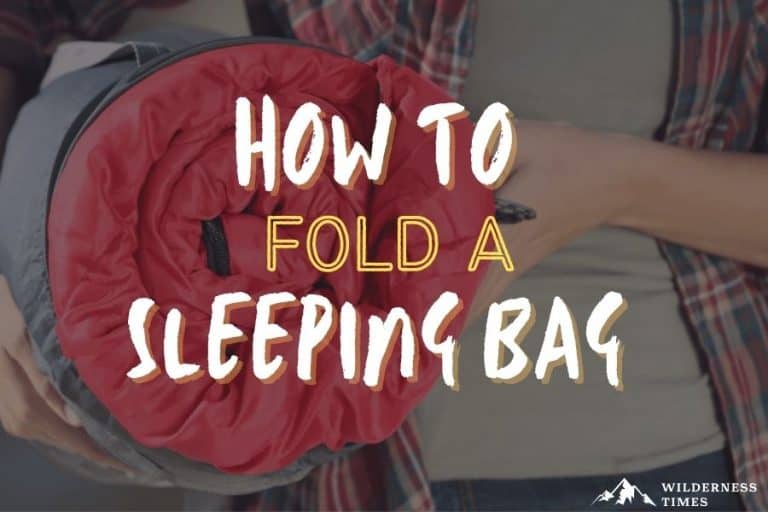Anyone who’s ever been camping knows all too well how frustrating it can be to fold your sleeping bag up and get it back in its stuff sack.
The struggle is real.
But let me let you in on a little secret: it doesn’t have to be that difficult.
In fact, by following just a few simple steps, you’ll have your sleeping bag folded and packed in no time, without pulling your hair out in the process.
Ready to learn how to fold a sleeping bag quickly and without any meltdowns? Here’s how:
- Step 1: Shake it out
- Step 2: Zip it up
- Step 3: Fold it in half
- Step 4: Roll it up
- Step 5: Stuff it in
Yep, it is THAT easy. But we’ll go over all the steps in detail and with images in the next section.
Table of Contents
ToggleHow To Fold A Sleeping Bag In 5 Simple Steps
The key to success, when you’re folding a sleeping bag, is following these 5 easy steps: shake, zip, fold, roll, and stuff.
Here’s what you need to know.
Step 1: Shake It Out
To begin with, lay your sleeping bag out flat on the ground.
Give it a good, thorough shake to get rid of any dirt, crumbs and anything else you might have left in there. Next, run your hands across the surface of the sleeping bag to get as much air out of it as possible, and get it nice and flat.
Note: if you’ve got a sleeping bag that’s wind or water-resistant, it’s a good idea to turn it inside out. This will make it easier to get all the air out of it and roll it up nice and tight.
Step 2: Zip It Up
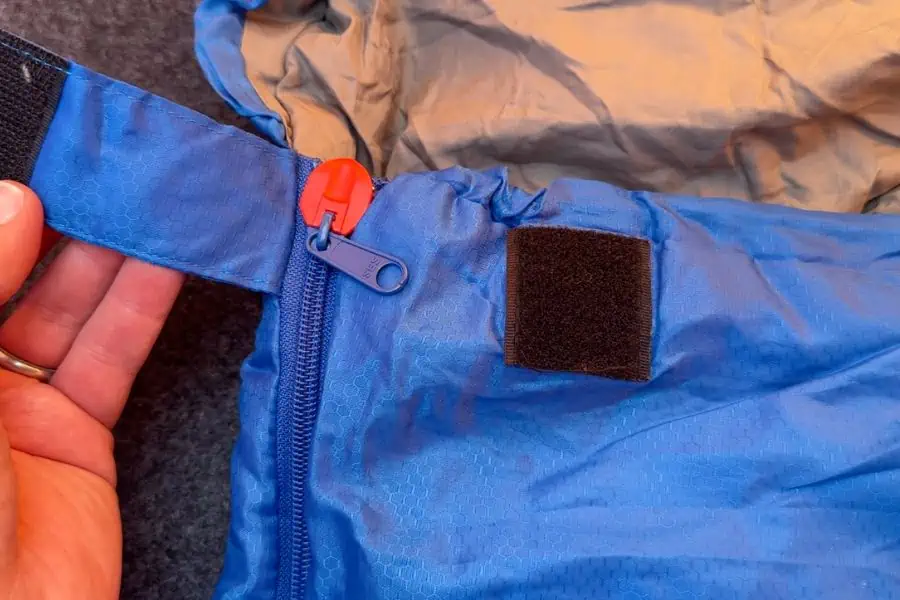
Next, zip your sleeping bag up.
Zipping your sleeping bag all the way up will make it much easier to keep it straight and even while you’re rolling it up.
While you’re pulling the zipper up, push as much air as you can out through the top of the sleeping bag.
Step 3: Fold It In Half
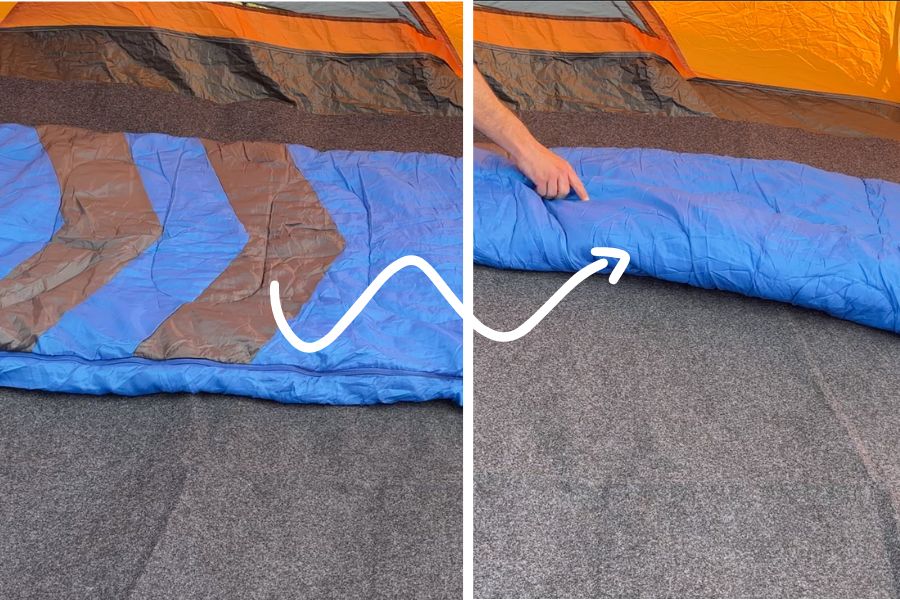
Fold your sleeping bag in half lengthways, making sure all the corners and edges line up perfectly.
This is important, or you won’t be able to roll it up as tightly as you need to in order to fit it into your stuff sack.
Step 4: Roll It Up
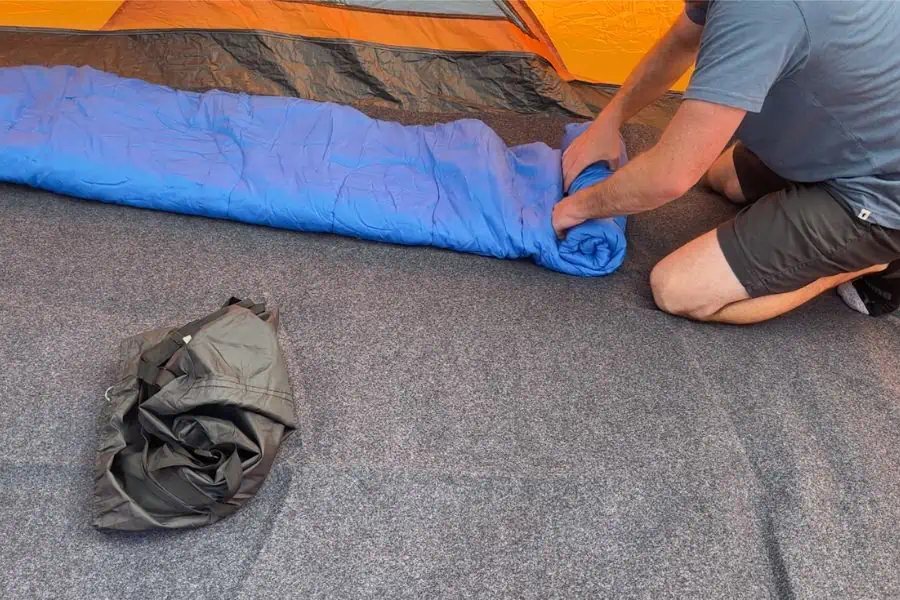
Finally – the moment of truth!
Starting at the open end of the sleeping bag, start rolling the sleeping bag up as tightly as you can.
As you’re rolling it up, continue to push as much air as you can out of the sleeping bag. Be sure to push down on the sleeping bag with your knees while you’re rolling it. This will help push air out and keep everything nice and tight.
If you’ve followed all the previous steps to a tee, you should end up with a nice, compact little bundle.
If you’re still having a hard time with this step, try rolling the sleeping bag around a tent pole or similar item. This can make it easier to roll it up tightly and evenly.
Note: If you’ve got straps of any kind, either attached to the actual sleeping bag or separate, use these to fasten your bundle once you’ve rolled it up. If the straps are near the head of the bag, begin rolling it from the bottom upwards, instead of the other way around.
Step 5: Stuff It In
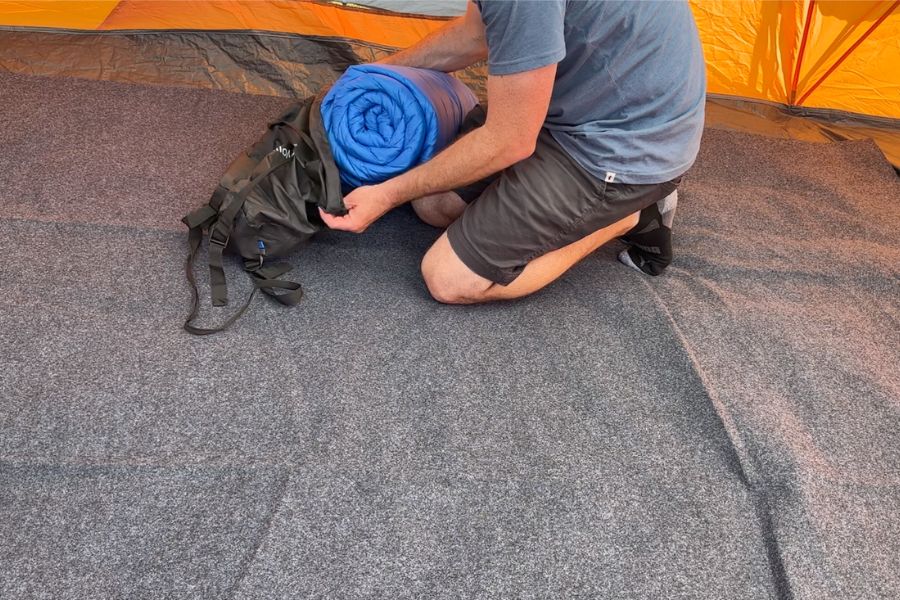
Finally, it’s time to get your sleeping bag into its stuff sack.
If your sleeping bag is fastened with straps, this part should be a piece of cake. Just slide the rolled sleeping bag into its storage sack the same way you’d put a pillow in a pillowcase.
If you don’t have any straps to fasten your bundle, it might be a bit trickier getting it back in its bag. Here’s my suggestion: try turning the stuff sack inside out.
From here, you can place the sleeping bag on one end of the stuff sack, and start pulling the edges of the sack up and around your bag. Eventually, the stuff sack will be right side out again, and your sleeping bag will be completely packed!
Tips and Tricks for Folding Sleeping Bags
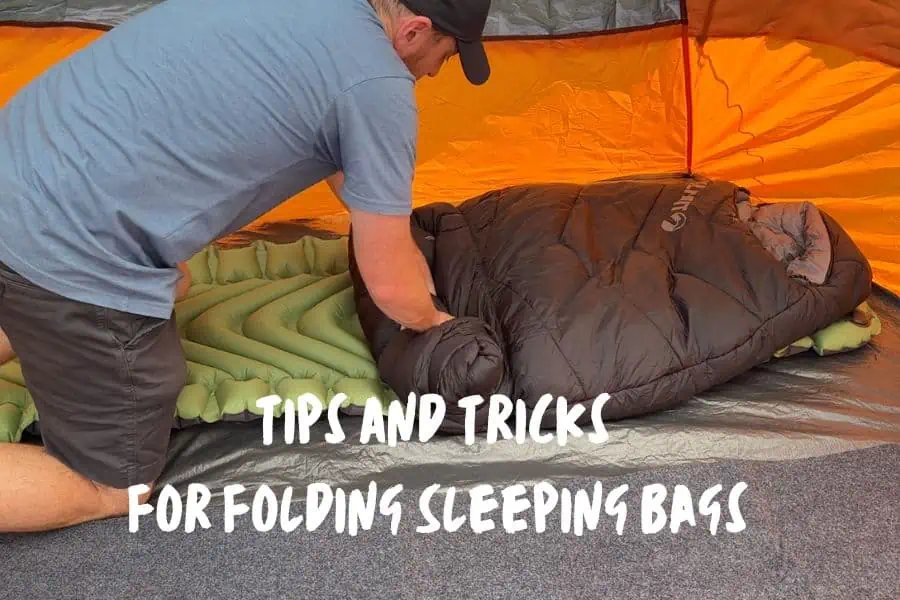
Here are a few tips and tricks to remember when folding up your sleeping bag.
Smooth out air pockets while rolling
As you roll up your bag, make sure to roll rightly and smooth out any air pockets.
The tighter your roll, the easier it will be to get your sleeping bag into its stuff sack.
Use a groundsheet or tarp to fold on a clean surface
Nothing could be worse than folding up your bag, only to find out you have dirt and other debris hanging out in your sleeping bag.
To avoid this, I make sure to fold our sleeping bags inside the tent, before we take it down. This way it is away from any dirt and debris.
But if for some reason you forgot to do that, you can always use a groundsheet or tarp.
Hang and air out your sleeping bag for 24 hours when you get home
Make sure to air out your sleeping bag for 24 hours when you get back from your camping trip.
Between campfire smoke and your sweat and body odors, this will help let it breathe and also ensure.
Store your sleeping bag uncompressed, in a cool, dry place
Too much compression is actually bad for your sleeping bag in the long run.
It doesn’t matter if it is down or synthetic, both will lose their lofting ability over time when compressed.
That is why it’s best to hang up your sleeping bag in your closet, or some other cool, dry place when not in use.
FAQ
Can I still fold up my sleeping bag if it’s wet or dirty?
As long as your sleeping bag is not soaked through, you’re able to pack it up with the folding technique we’ve covered above. The same goes for if it’s dirty.
However, in the event of an (even slightly) damp sleeping bag, it’s important to block out some time for it to dry out in the sun either before you break camp, or when you’re setting up camp for the evening.
Do I need to use a groundsheet or tarp when folding my sleeping bag?
Not necessarily! You can pack up your sleeping bag in almost any environment.
However, most campers will pack up their bags in their tent before they break it down, so they can use the space inside for folding and stuffing – and avoid any unnecessary dirt.
What’s the difference between a compression stuff sack and a regular stuff sack?
A “regular” stuff sack is just a regular storage bag to keep your sleeping bag in. Most sleeping bags will come with one of these included.
On the other hand, a compression sack, well, compresses your sleeping bag further! This type of stuff sack makes your sleeping bag as compact as possible.
Compression sacks are useful for backpacking, as reducing the size of your sleeping bag as much as possible means more room in your backpack. As every backpacker knows, every last inch of space counts.
Should I keep my sleeping bag folded at home when I’m not using it?
No, you should always unpack your sleeping bag and hang it up to air it out when you get home. After a period of at least 24 hours, you can fold your sleeping bag up loosely and store it, or leave it hanging in your closet while it’s not in use.
Keeping your sleeping bag rolled up over long periods of time will reduce the effectiveness of the bag’s insulation, whether it’s down or synthetic.
What are the benefits of properly folding and storing a sleeping bag?
Properly folding your sleeping bag on the trail, and storing it well at home will keep your sleeping bag in good shape for longer!
If you take care of your gear, your gear will take care of you – and you won’t need to be in the market for a new sleeping bag for a while.
Does the folding process change if I have a mummy sleeping bag instead of a rectangular sleeping bag?
With a mummy bag, you’ll want to start rolling it from the bottom, finishing up at the top.
Other than that, the rest of the procedure is exactly the same, so you can follow the above steps with both mummy shaped and rectangular sleeping bags.
Does it make a difference if my bag has down insulation instead of synthetic insulation?
A down sleeping bag is easier to compress than a synthetic bag. Down is known for its outstanding compressibility, while a synthetic sleeping bag won’t compress nearly as well.
Some bags are filled with a down-synthetic mix, which compresses better than synthetic does on its own, but still not as well as a down bag.
Summary
See? Not so hard after all, right? Just shake, zip, fold, roll, and stuff. That’s all there is to it!
Now that you know how to fold a sleeping bag, you’ll be able to pack up camp in a matter of minutes. No more unnecessary hassles at the end of a relaxing camping trip.
Thank goodness for that, am I right?
More On Sleeping Bags
- The 17 Best Sleeping Bag Brands (From Budget to Backpacking)
- Mummy vs Rectangular Sleeping Bag (A Side By Side Comparison)
- Quilt vs Sleeping Bag – Which Is Better For Backpacking?
- Down vs. Synthetic Sleeping Bag (Which is Better?)
- How To Wash A Sleeping Bag (A Comprehensive Guide)
- Sleeping Bag Selection Tips: Left Or Right Hand Zip?


